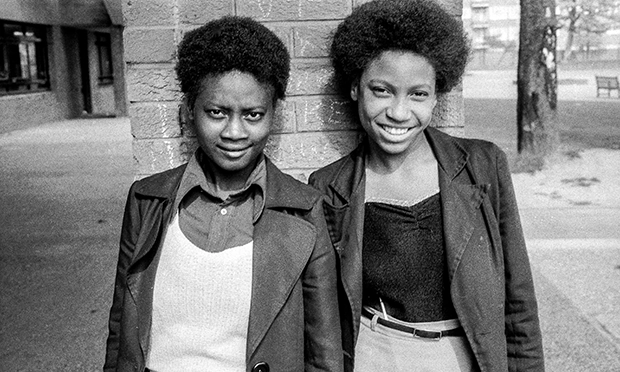Local residents are the stars of new exhibition charting 50 years of life in Hackney

Stoke Newington School, 1974. Photograph: Neil Martinson
“Some young kids who are obsessed with football, they sleep with a football next to their bed. With me, it was a camera and I pursued it,” said photographer Dennis Morris.
His work will be on display in an upcoming Hackney Museum exhibition that celebrates the lives of local residents over the last half a century.
At Home in Hackney opens on 14 September and runs until 24 February.
Also set to feature are the Hackney Flashers co-operative of women photographers in the 1970s, Neil Martinson, who is currently documenting the exhibition, Turner Prize winner Rachel Whiteread, Future Hackney, and up-and-coming talents.
There will be outdoor pop-up shows around Hackney in October and November, and local photographer Tom Hunter has also curated a film season at the Picturehouse.
Morris was speaking from Los Angeles where he is working on a Bob Marley book, but he hopes to visit the exhibition.
He had his first photo published on the front page of the Daily Mirror when he was just 11. He got a lucky break when he bunked off from Upton House School in Homerton to wait for Bob Marley to do a sound check at the Speak Easy Club in Margaret Street.
The Dalston-born schoolboy was invited to take pictures of the singer’s tour, which included candid photos of musicians including Goldie, Johnny Rotten and Oasis. It launched his photographic career.
For him, photography is about “capturing the defining photo”. He said few people have the “third eye” to compose and capture a great photo.
“You see the unseen with the third eye,” he added.
“I have been able to capture the essence of my subject. What I have been able to do is take off the mask, because everybody wears a mask.”
His work is in the V&A, Tate, and he also donated photos to Hackney Museum.
The exhibition features an image he shot of local legend Admiral Ken, famous for his sound system.
He took photos as the heavy speakers were unloaded.
Morris said: “To get that shot, I was aware of the sound system and the movement.
“I was a little bit too young to be out at 3am or 4am so I turned up early to get a set of shots.”
His style of reportage helped capture the “enormous changes in Hackney” and the diversity in the borough.
“Hackney has always been a unique area,” he said. “It’s always been a very welcoming area.”
He hopes visitors to the exhibition will “get a sense of the people from the period when I was growing up in Hackney. It has a certain strength and a very strong sense of community.”
He added: “Someone who saw my Growing Up Black work at an exhibition in Japan said, ‘All of your subjects have a sense of joy’.”
Morris said: “Everyone was well dressed.”
He described one of his pictures which exemplifies this. Despite poor housing with a curtain dividing a room and a washing line hanging up in the room, “this guy was wearing a sharp suit and a pork pie hat. There was so much joy in the community at the time in the 1970s, but it was rough and tough.”
He said aspiring photographers in Hackney should “just keep on keeping on. Always believe in your ability, just keep on keeping on and circumvent those obstacles. Go round them, don’t let them crush you. Just keep yourself together and focus on yourself.”
He added: “The power of the photograph is the image can bring it all back. You can look at a photograph from 10 years ago and suddenly you can access it. You remember everything: the conversation, the smell, the laughter. That’s the power of the image.”
